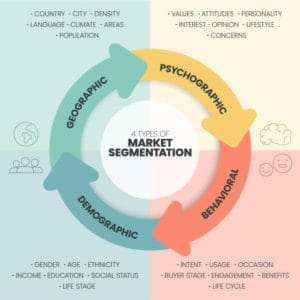In the market, we can see different types of shoes such as running shoes, soccer shoes, and basketball players’ shoes produced by sport footwear companies.
Do you think is it an effective way of reaching basketball players and long-distance runners with the same marketing message and ad campaigns?
And Do they have similar interests or can be equally satisfied with the same shoes?
The answer is simple, “ No “.
Here, segmenting consumer markets play a crucial role because these customers have different interests, different needs, and want in terms of shoes, and different ways of communication and campaign messages are required. Today, I am going to try to explain What is Market Segmentation and Why does it matter? And types of Market segmentation with examples.
What Is Market Segmentation?
Market Segmentation is a systematic approach that allows companies to divide large diverse markets into distinct groups of prospective buyers who have different needs, characteristics, and behaviors and design products, communications, and marketing strategies around them.
Buyers in any market differ in their wants, locations, buying attitudes, and buying practices. Through Market Segmentation, marketers carry out market research that helps them identify the parts of the market they can serve best and most profitably.
In short, it is the process of finding out what customers, will we serve. This prevents the company from reaching lots of consumers who are not interested in its products or services and in turn, saves lots of advertising dollars along with the improved return on investment (ROI)
Types Of Market Segmentation
There are 4 most common types of segment variables that companies use to find out their customers’ segments and tailor their marketing messages and strategies according to them.
Below I will look at the major geographic, demographic, psychographic, and behavioral segmentation variables
1. Demographic Segmentation
Demographic segmentation is one of the most used forms and a straightforward way of splitting up customer groups based on people-based variables such as age, gender, income, race, education, or occupation.
Demographic factors are considered the fundament for segmenting customer groups. This is because, consumer needs, wants and usage rates often differ closely in with demographic variables.
For example, personal care companies start segmenting the market according to gender: men’s and women’s personal care products like different body bars or deodorant for both gender.
Or automobile manufacturers and clothing companies divide their customer groups based on income. These BMW, Mercedez Benz, or luxury clothing brands such as Louis Vuitton, and Gucci will serve affluent consumers. So the company can discover its customer segments based on collected demographic data.
Geographic Segmentation
Geographic segmentation is to categorize customer groups in line with geographical units, such as nations, regions, states, and cities. An organization may serve one or a few geographical areas by identifying differences in the needs and wants of the customers.
Furthermore, they can localize their offerings, promotions, or sales efforts to fit the needs of individual regions, cities, and other localities.
Geographic variables are Climate, Cultural preferences, and Population types. For instance, IKEA, the leading company in the furniture industry, use geographic, demographic, and psychographic segmentation to fulfill their customer’s needs. They offer products and implement promotional activities based on the cultural preferences or climate in Europe, South America, Asia, and Australia.
Behavioral Segmentation
Behavioral segmentation is grouping customers based on their behavior, knowledge, and responses to a product. Behavioral segmentation depends on market data, consumer actions, and the decision-making patterns of customers.
It is believed that behavior variables are the best starting point for building market segments. Behavior variables are spending habits, User sought, User Status, User Rate, and Loyalty Status.
Benefits Sought: it is grouping buyers based on different benefits that they seek from a product. This subsegment requires finding the major benefits people look for in a product class and the major brands that offer each benefit. For example, Fitbit introduced different types of fitness-tracking devices such as Everyday Fitness, Active Fitness, and Performance Fitness according to the Users’ benefit preferences.
User Status: market can be divided into nonusers, ex-users, potential users, first-time users, and regular users of a product. The company can deliver promotional messages based on it
User Rate: There are different types of consumers according to their usage rate. They can be split up into heavy medium, light users, or non-user of a product. Heavy users are often a small percent of the market but account for a high percentage of total consumption.
Psychographic Segmentation
Psychographic Segmentation categorizes buyers into different segments based on lifestyle, personality, and interests.
This consumer segment is similar to demographic segmentation but Psychographic segmentation addresses characteristics that are more mental and emotional. Consumers in the same demographic group can have very different psychographic characteristics.
These attributes may change easily and may not be as straightforward to observe as demographics. There may not have readily available objective data but they can give the company valuable insights into their customers’ preferences, needs, and motives.
For example, from the lifestyle of people, Royal Dutch Gazelle offers different types of bikes for different kinds of customers. They produce City Bikes for short trips, and commuting work, Trekking bikes that are sporty and lightweight, and e-bikes for daily use.
In Conclusion
In the consumer market, people differ in their wants, locations, buying attitudes, and buying practices. Understanding and dividing the market allow the company reaches its segments more efficiently and effectively with products and services that fit its unique needs.
Moreover, Market segmentation helps the company stay more focused on its segments, improved customer retention, and create differentiation from your competitors








